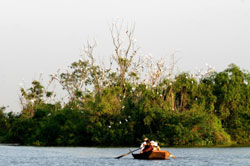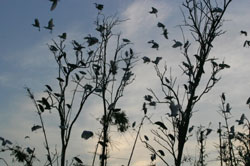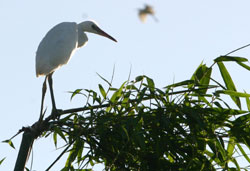For thousands of years, the popularity and beauty of white storks have
made them one of the cultural symbols of Vietnam but city residents
only have rare opportunities to see them these days as they isolate
themselves in rural areas as urbanisation sets in.
 |
| What are you looking at? Chi Lang Island has been quietly attracting bird-watchers. |
 |
| Birds of a feather: Thousands of storks gather on the island |
 |
| Motherly love: Storks generally leave their nests to seek food in the early morning. — VNA/VNS Photos Truong Vi |
Chi Lang Island has been quietly attracting bird-watchers – around 15,000 annually – to this out-of-the-way part of the province since the early 1990s.
December is well-known as a great time for bird watchers here as the changing season heralds the arrival of tens of thousands of storks.
I pay VND20,000 (USD1) to join a boat ride with a group of others. Our guide, Nguyen Duc Ban, 68, says the island is primarily home to nine varieties of birds, including Chinese pond herons, jabirus, buff-backed and grey herons, and grey, blue and black bitterns, which stop off on their way to China, Myanmar, India and Nepal.
As legend has it, a sudden storm damaged a dyke in the 15th century and the resulting flood transformed the rice fields within into a deep lake and turned the local temple into the small island. Locals came to believe the lake is holy and never do any thing to harm it nor the creatures that make it their home. As time has passed, an increasing number of storks and herons have come to stay on the island.
The best time to visit the island is either in the early morning or at sunset because these are when the birds typically shift their eating times.
The white storks generally leave their nests to seek food in the early morning when the grey herons return to their roosts after finding their fill. The reverse is true in the late afternoon when all the white storks return to their nests and the grey herons take off to forage again.
I fully enjoy watching the birds fly over our heads or land on the nearby trees under the golden shade of the sunset. Their gentle calls only add to the beautiful picture they make beneath the setting sun.
Storks choose Thanh Mien over other areas of the province because of the abundance of shrimp and fish, both wild and cultivated.
Local residents are aware of the tourism potential the birds present so they do their best to protect them rather than hunt them for meat. Ban says some people even let the storks eat fish from their ponds.
Storks collect straw and other grasses to build their nests in bamboo and eucalyptus trees. They lay eggs four separate times between September to April each year, with six eggs each time. After 25 days of incubating, a small stork is born. After a short 60 days of being fed and trained to fly by their parents, the young storks are able to search for food independently. Ban tells me there are currently about 10,000 storks and 7,000 night herons.
In the past, storks typically limited their stay at the lake to between September to April, but now they live here throughout the year. The growing population has put pressure on the bamboo trees in the area, so locals are thinking about planting more trees to meet their needs.
Like many other people here, Ban loves the birds but he is worried about how to ensure that their development is sustainable, saying "If there are too many birds, I don't really think we have enough space and food to accommodate them."

Leave your comment on this story